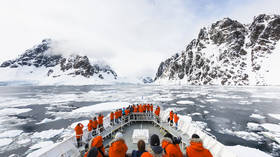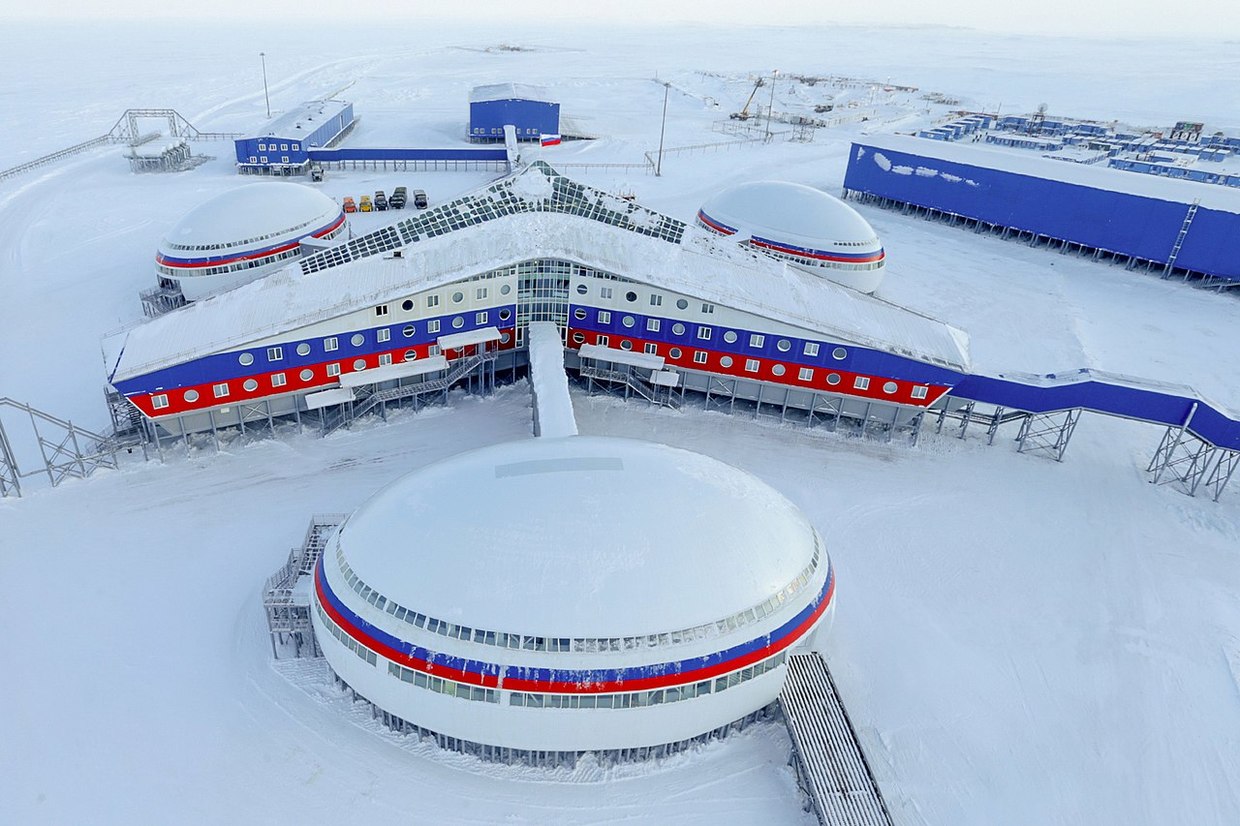As Russia launches more nuclear ice-breakers, how global warming could lead to a new hotspot in the Arctic

Exactly 65 years ago, the world’s first nuclear icebreaker, the ‘Lenin’, was launched in the USSR. With this event, Moscow loudly announced its ambitions to develop the northern seas. Though the Arctic has remained on the periphery of world leaders’ attention for a long time, due to global warming the region is now becoming something akin to another ‘Klondike’ for natural resources.
The erstwhile Russian Empire claimed its rights to this region at the beginning of the last century, but, given the current circumstances, not all Arctic nations are ready to cede leadership to Moscow in developing the Arctic Ocean. Consequently, the region is increasingly becoming the focus of potential tensions in international relations.
The power of Russian icebreakers…
On December 5, 1957, the first nuclear-powered surface vessel in world history and the Soviet Union’s first atomic icebreaker, the ‘Lenin’, was launched. It was transferred to the USSR’s Naval Ministry two years later and was created to serve the Northern Sea Route (NSR).
On the eve of the 65th anniversary of this event, Moscow made another major statement: at the end of November 2022, the third icebreaker in Project 22220, the ‘Yakutia’, was launched. It will be completed on the water. According to various sources, commissioning is scheduled for late 2024 or early 2025. This vessel will also work to ensure the safe passage of ships along the Northern Sea Route.
At almost the same time, the icebreaker ‘Ural’ arrived on the scene. A total of seven nuclear icebreakers are currently in service with Atomflot. Today, Russia is the only country in the world with its own fleet of this type, without which the development of the polar regions surrounding the NSR would be almost impossible.

While atomic-powered ships were mostly used for excursions up until 2010, they have now taken on strategic importance for exploring the Arctic. The Russian company Rosatom has mastered production of nuclear icebreakers and now turns them out more often than before. This indicates that it won’t be easy to catch up with Moscow in this area, if it’s even possible at all. This is a cause for concern among Western countries.
“In recent years, Moscow has made it more than abundantly clear that it sees the region as its own and has built up its military presence,” writes Peter Suckau, a columnist for 19FortyFive.
America’s top brass also complains about this. “Russia is refurbishing Soviet-era airfields and radar installations, constructing new ports and search-and-rescue centers, and building up its fleet of nuclear- and conventionally-powered icebreakers. It is also expanding its network of air and coastal defense missile systems, thus strengthening its anti-access and area-denial capabilities over key portions of the Arctic,” Pentagon spokesman Lieutenant Colonel Thomas Campbell said last year.
… and US concern
It’s not only Russian icebreakers that are causing tension in the Arctic. Almost every step Russia takes towards building infrastructure in the region elicits a harsh reaction from international – especially American – observers.
For example, on August 1, 2022, the Russian government approved a plan to develop the NSR by 2035. The main goal set out in the document is to ensure reliable and safe transportation of freight and goods to benefit the people living in the Far North, and also to facilitate investment projects in the country’s Arctic zone.
The scheme includes the construction of a liquefied natural gas (LNG) and gas condensate terminal, oil and coal terminals, onshore and hydraulic structures, LNG marine transportation complexes, a hub port for transportation, and other infrastructure.
These plans have provoked sharp criticism in the American press. “Over the 20 years of the council’s [the Arctic Council] existence, Moscow has made outrageous land claims and embarked on aggressive oil exploration in the region,” The Hill columnist Diana Francis wrote in August.

The White House has not stood aside either. Seeing how Russia has begun to focus its attention on the Arctic region, the US has also expressed its intent to “up its game” by creating the post of ambassador-at-large for the Arctic region expressly for this purpose.“This official will be based here at the State Department, which will reflect our continued strong commitment to high-level Arctic cooperation [with other countries],” State Department Adviser Derek Scholle announced in late October 2022 during an online briefing.
Cooperation or competition?
Russia has repeatedly stressed that it has no issues in the Arctic that require a military solution, asserting that what the US calls “strengthening Russia” is just part of Moscow’s efforts to strengthen its ability to defend its own borders.
“The United States has always reacted nervously to the development of Russia’s Arctic programs. Washington has always found it difficult to accept virtually any activity on the part of Moscow in the region, and in the context of global warming and active melting of ice, American politicians have begun to see the Arctic as a possible battlefield in the future. Based on this, the Americans are doing everything possible to limit Russia in this region, and this topic has become more and more acute lately,” Oleg Barabanov, program director of the Valdai Discussion club and a professor at Russia’s Higher School of Economics (HSE), told RT.
However, there may be a different explanation for American officials making such statements. Last year, Washington adopted a new doctrine of action in the Arctic aimed at countering Russia and China in the region.
In particular, a multi-domain task force is to be formed from ground forces in Alaska, which will include a division headquarters with trained and equipped brigades. Training centers and training grounds will be created immediately. In addition, it proposes that the US Air Force and Navy maintain a permanent presence in the Arctic.
“A multi-domain operational unit, especially with extended range, has clear advantages for conducting combat operations in the Arctic. Air and sea communications are crucial in this region, with its vast distances,” the strategic plan notes.

One thing is obvious: the increasing stakes and attention are turning the Arctic into a region where not only the political, but also the geopolitical and economic, interests of the leading powers may collide.
The socio-political discourse surrounding the Arctic that has emerged in recent years boils down to answering the main question: What is the priority for the countries vying to participate in Arctic projects – cooperation or confrontation? Russia has called for joint negotiations to settle the legal aspects of the use of the Arctic space within the auspices of the Arctic Council, which Moscow currently chairs. However, in the spring of 2022, the other member countries refused to participate in any Arctic Council events. Moreover, the US has made it clear that it sees Moscow’s efforts as an attempt to establish military-strategic control over the region.
“It is quite possible that the Arctic will become the next point of tension precisely because of the militarization of the region, which is already a serious problem,” Barabanov believes.
Why is Russia laying claim to the Arctic?
Russia declared its rights to the Arctic region back in 1916, a stance that Moscow did not abandon during the 20th century. However, in recent years, developing the Arctic has once again become a priority in Russian politics, which should not be surprising. The total area of Russian territory located in the Arctic zone adds up to 3 million km2 (including 2.2 million km2 of land), amounting to 18% of Russia’s entire territory. About 2.4 million people live there. For a country the size of Russia, this is not much – less than 2% of the population – but these 2.4 million people represent 40% of the Arctic’s total population.
Another aspect is also fundamentally important – a lot of natural resources are concentrated on the Arctic Shelf, an offshore area that itself has a unique geographical location.
Scientists estimate that the shelf contains up to a quarter of Russia’s oil reserves and almost half of its gas. This breaks down to 49% in the Barents Sea, 35% in the Kara Sea, and 15% in the Okhotsk Sea.
Moscow first attempted to determine the borders of the continental shelf back in 2001. At that time, Russia sent an idea about expanding its borders on the Arctic shelf to the relevant UN Commission. Moscow provided data from a study of the seabed topography, which showed that the Lomonosov and Mendeleev underwater ridges running along the bottom of the Arctic Ocean are a continuation of the Siberian continental platform. However, that application was rejected.

In 2016, Russia submitted another application, supplemented with fresh scientific data. In 2019, the UN Sub-Commission adopted an interim decision, in which it was recognized that part of the Arctic territory geologically belongs to Russia’s continental shelf. However, no final decision has been made so far.
There are currently two approaches for determining the status of Arctic lands and waters. According to the first, this can be exclusively considered open sea with the corresponding rules for ship movement. The second implies that the Arctic Ocean can be considered a kind of national territory of the adjacent country.
If we take the second approach, then countries can claim preferential rights to Arctic sectors due to their geographical location and historical context. These sectors are determined by the meridians passing along the western and eastern coastal borders of a country. In this case, Russia’s Arctic sector would amount to about 9 million km2, of which the marine area would account for 6.8 million km2.
Russia, Norway, Denmark, Canada, and the US can lay direct claim to parts of the Arctic shelf. However, according to current international legislation on this issue, the Arctic countries have no special rights to the Arctic – even due to their geographical location. According to the UN Convention on the Law of the Sea of 1982 (Russia ratified the document in 1997), a country’s full sovereign territorial rights only extend 12 miles into coastal waters, while its economic zone, where it has the right to extract minerals, stretches out to 200 miles. At the same time, Article 77 of the same convention states that countries can exercise their sovereign rights (for example, to extract minerals) throughout their continental shelf.
The ice is melting
However, the root of the discussions is economic. In recent years, centuries-old Arctic ice has been melting, opening access to resources and other economic benefits. The main thing that Russia is focusing on is the opportunities that are emerging to use the Northern Sea Route more actively. Due to climatic change, glaciers have begun to melt rapidly, leaving more and more days per year on which the transport artery is available. If global warming cannot be curbed, the Arctic Ocean will be free from ice in the current century, according to some estimates.

Despite certain negative environmental consequences, this opens up new economic opportunities for using the Northern Sea Route, the advantages of which are obvious – the distance from St. Petersburg to Vladivostok is slightly more than 14,000 km, whereas goods would have to be transported over 23,000 km if routed through the Suez Canal. Accordingly, the speed of shipping goods between Asia and Europe can increase.
Russia’s desire for the Northern Sea Route to become a leading international sea route is understandable. The use of this transport corridor will bring benefits to all of Europe – the route between the EU and Asia will be almost halved.
However, it is this fact, combined with Russia’s requirements for the passage of ships, that elicits thinly concealed irritation from the US.
“They require any vessel transiting the NSR through international waters to have a Russian pilot onboard to guide the vessel. Russia is also attempting to require foreign vessels to obtain permission before entering the NSR,” Pentagon spokesman Thomas Campbell said in 2021. The official further claimed that Russia’s demonstration of its military might in the north is the key to understanding Moscow’s nuclear strategy, and that Russia’s policy in the Arctic region itself could be an attempt to impose its authority over wider territories.
At the same time, researchers from the HSE believe that, in addition to the economic benefits that will come from opening the NSR, the liberation of the Arctic from ice will also bring serious risks to Russia.
First of all, this is because the natural buffer between Russia and the US provided by the ice mass will disappear, and this may increase the rivalry between Moscow, Washington, and Beijing in the region, while contributing to its general militarization. Over the past few years, the US (the Defense Department, Air Force, and Army) has been publishing new military Arctic strategies, which involve increasing the American military presence in the Arctic. This approach on the part of the US cannot but threaten Russian economic interests in the region, according to the authors of a HSE report titled ‘Russia’s Arctic Policy: International Aspects’. Moreover, the militarization of oceans will clearly not facilitate international cooperation in this region.

In addition, the potential the Arctic presents is beginning to be appreciated by other countries (for example, China), which want to revise the existing system under which the Arctic is governed by neighboring states. As a result, scientists expect international competition to only increase here.
“Now, in addition to the Arctic countries, the region is receiving more and more attention from Asian countries – China, India, Singapore, Japan, and South Korea. Firstly, they are interested in the development of Arctic routes. Secondly, they are striving to demonstrate their contribution by actively participating as observers in various Arctic events. So, the sphere of politics in the Arctic is expanding,” says Barabanov.
In this regard, Russian experts are sure there is difficult diplomatic work ahead if Russia is to harmonize relations with all countries interested in participating in Arctic projects.
Nonetheless, the HSE professor believes that hot conflicts should not be expected any time in the near future.
“But again, in the future, it is impossible to rule out the possibility of incidents occurring, including at sea. With climate change, the sea will become increasingly wide, and such incidents are possible. Therefore, the increase in the level of tension surrounding the Arctic should be taken seriously,” he told RT.


















